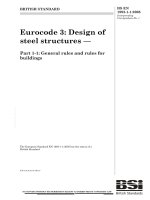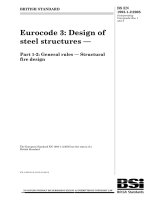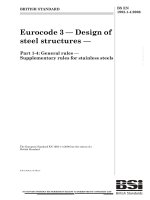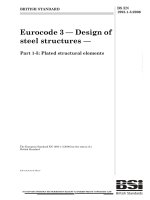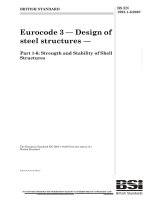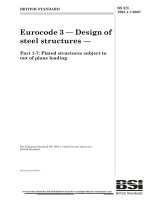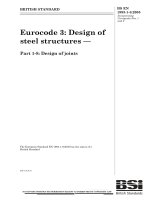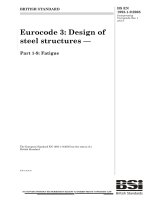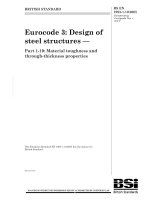Tiêu chuẩn Châu Âu EC3: Kết cấu thép phần 1.9: Độ mỏi (Eurocode3 BS EN1993 1 9 e 2005 Design of steel structures part 1.9: Fatigue)
Bạn đang xem bản rút gọn của tài liệu. Xem và tải ngay bản đầy đủ của tài liệu tại đây (986.19 KB, 40 trang )
BRITISH STANDARD
BS EN
1993-1-9:2005
Incorporating
Corrigenda Nos. 1
and 2
--```,,`,`````,,`,,``,`,,,,,`,,-`-`,,`,,`,`,,`---
Eurocode 3: Design of
steel structures —
Part 1-9: Fatigue
The European Standard EN 1993-1-9:2005 has the status of a
British Standard
ICS 91.010.30
12 &23<,1* :,7+287 %6, 3(50,66,21 (;&(37 $6 3(50,77(' %< &23<5,*+7 /$:
BS EN 1993-1-9:2005
National foreword
This British Standard is the official English language version of
EN 1993-1-9:2005, including Corrigendum December 2005. It supersedes
DD ENV 1993-1-1:1992, which is withdrawn.
NOTE Corrigendum No. 1 implements a CEN Corrigendum which adds “P” after the clause
number and replaces the word “should” with “shall” in 2(1).
The structural Eurocodes are divided into packages by grouping Eurocodes for
each of the main materials, concrete, steel, composite concrete and steel,
timber, masonry and aluminium, this is to enable a common date of
withdrawal (DOW) for all the relevant parts that are needed for a particular
design. The conflicting national standards will be withdrawn at the end of the
coexistence period, after all the EN Eurocodes of a package are available.
--```,,`,`````,,`,,``,`,,,,,`,,-`-`,,`,,`,`,,`---
Following publication of the EN, there is a period allowed for national
calibration during which the national annex is issued, followed by a coexistence
period of a maximum 3 years. During the coexistence period Member States are
encouraged to adapt their national provisions. Conflicting national standards
will be withdrawn by March 2010 at the latest.
BS EN 1993-1-9 will partially supersede BS 5400-10 and BS 7608 which will
be withdrawn by March 2010.
The UK participation in its preparation was entrusted by Technical Committee
B/525, Building and civil engineering structures, to Subcommittee B/525/31,
Structural use of steel, which has the responsibility to:
—
aid enquirers to understand the text;
—
present to the responsible international/European committee any
enquiries on the interpretation, or proposals for change, and keep UK
interests informed;
—
monitor related international and European developments and
promulgate them in the UK.
A list of organizations represented on this committee can be obtained on
request to its secretary.
Where a normative part of this EN allows for a choice to be made at national
level, the range and possible choice will be given in the normative text, and a
note will qualify it as a Nationally Determined Parameter (NDP). NDPs can be
a specific value for a factor, a specific level or class, a particular method or a
particular application rule if several are proposed in the EN.
To enable EN 1993-1-9 to be used in the UK, the NDPs will be published in the
National Annex, which will be made available by BSI in due course, after
public consultation has taken place.
Amendments issued since publication
This British Standard, was
published under the authority
of the Standards Policy and
Strategy Committee on
18 May 2005
Amd. No.
Date
Comments
16292
June 2006
See note in National foreword
16570
29 September 2006
Revision of national foreword and
supersession details
Corrigendum No. 1
Corrigendum No. 2
© BSI June 2006
ISBN 0 580 46079 7
BS EN 1993-1-9:2005
This publication does not purport to include all the necessary provisions of a
contract. Users are responsible for its correct application.
Summary of pages
--```,,`,`````,,`,,``,`,,,,,`,,-`-`,,`,,`,`,,`---
Compliance with a British Standard does not of itself confer immunity
from legal obligations.
This document comprises a front cover, an inside front cover, page i, a blank
page, the EN title page, pages 2 to 34, an inside back cover and a back cover.
The BSI copyright notice displayed in this document indicates when the
document was last issued.
i
--```,,`,`````,,`,,``,`,,,,,`,,-`-`,,`,,`,`,,`---
blank
EN 1993-1-9
EUROPEAN STANDARD
NORME EUROPÉENNE
EUROPÄISCHE NORM
May 2005
ICS 91.010.30
Supersedes ENV 1993-1-1:1992
Incorporating Corrigendum
December 2005
English version
Eurocode 3: Design of steel structures - Part 1-9: Fatigue
Eurocode 3: Calcul des structures en acier - Partie 1-9:
Fatigue
Eurocode 3: Bemessung und Konstruktion von Stahlbauten
- Teil 1-9: Ermüdung
This European Standard was approved by CEN on 23 April 2004.
CEN members are bound to comply with the CEN/CENELEC Internal Regulations which stipulate the conditions for giving this European
Standard the status of a national standard without any alteration. Up-to-date lists and bibliographical references concerning such national
standards may be obtained on application to the Central Secretariat or to any CEN member.
This European Standard exists in three official versions (English, French, German). A version in any other language made by translation
under the responsibility of a CEN member into its own language and notified to the Central Secretariat has the same status as the official
versions.
EUROPEAN COMMITTEE FOR STANDARDIZATION
COMITÉ EUROPÉEN DE NORMALISATION
EUROPÄISCHES KOMITEE FÜR NORMUNG
Management Centre: rue de Stassart, 36
© 2005 CEN
All rights of exploitation in any form and by any means reserved
worldwide for CEN national Members.
B-1050 Brussels
--```,,`,`````,,`,,``,`,,,,,`,,-`-`,,`,,`,`,,`---
CEN members are the national standards bodies of Austria, Belgium, Cyprus, Czech Republic, Denmark, Estonia, Finland, France,
Germany, Greece, Hungary, Iceland, Ireland, Italy, Latvia, Lithuania, Luxembourg, Malta, Netherlands, Norway, Poland, Portugal, Slovakia,
Slovenia, Spain, Sweden, Switzerland and United Kingdom.
Ref. No. EN 1993-1-9:2005: E
EN 1993-1-9 : 2005 (E)
Contents
Page
1
General ................................................................................................................................................. 6
1.1
1.2
1.3
1.4
Scope ................................................................................................................................................. 6
Normative references......................................................................................................................... 6
Terms and definitions ........................................................................................................................ 6
Symbols ............................................................................................................................................. 9
2
Basic requirements and methods ....................................................................................................... 9
3
Assessment methods ...........................................................................................................................10
4
Stresses from fatigue actions .............................................................................................................11
5
Calculation of stresses ........................................................................................................................12
6
Calculation of stress ranges ...............................................................................................................13
6.1
6.2
6.3
6.4
6.5
7
Fatigue strength ..................................................................................................................................14
7.1
7.2
--```,,`,`````,,`,,``,`,,,,,`,,-`-`,,`,,`,`,,`---
8
General .............................................................................................................................................13
Design value of nominal stress range ...............................................................................................13
Design value of modified nominal stress range................................................................................14
Design value of stress range for welded joints of hollow sections...................................................14
Design value of stress range for geometrical (hot spot) stress .........................................................14
General .............................................................................................................................................14
Fatigue strength modifications .........................................................................................................17
Fatigue verification.............................................................................................................................18
Annex A [normative] – Determination of fatigue load parameters and verification formats .................30
Annex B [normative] – Fatigue resistance using the geometric (hot spot) stress method........................33
2
EN 1993-1-9 : 2005 (E)
Foreword
This European Standard EN 1993, Eurocode 3: Design of steel structures, has been prepared by Technical
Committee CEN/TC250 « Structural Eurocodes », the Secretariat of which is held by BSI. CEN/TC250 is
responsible for all Structural Eurocodes.
This European Standard shall be given the status of a National Standard, either by publication of an identical
text or by endorsement, at the latest by November 2005, and conflicting National Standards shall be withdrawn
at latest by March 2010.
This Eurocode supersedes ENV 1993-1-1.
According to the CEN-CENELEC Internal Regulations, the National Standard Organizations of the
following countries are bound to implement these European Standard: Austria, Belgium, Cyprus, Czech
Republic, Denmark, Estonia, Finland, France, Germany, Greece, Hungary, Iceland, Ireland, Italy, Latvia,
Lithuania, Luxembourg, Malta, Netherlands, Norway, Poland, Portugal, Slovakia, Slovenia, Spain, Sweden,
Switzerland and United Kingdom.
Background to the Eurocode programme
In 1975, the Commission of the European Community decided on an action programme in the field of
construction, based on article 95 of the Treaty. The objective of the programme was the elimination of
technical obstacles to trade and the harmonization of technical specifications.
Within this action programme, the Commission took the initiative to establish a set of harmonized technical
rules for the design of construction works which, in a first stage, would serve as an alternative to the national
rules in force in the Member States and, ultimately, would replace them.
For fifteen years, the Commission, with the help of a Steering Committee with Representatives of Member
States, conducted the development of the Eurocodes programme, which led to the first generation of
European codes in the 1980s.
In 1989, the Commission and the Member States of the EU and EFTA decided, on the basis of an agreement1
between the Commission and CEN, to transfer the preparation and the publication of the Eurocodes to CEN
through a series of Mandates, in order to provide them with a future status of European Standard (EN). This
links de facto the Eurocodes with the provisions of all the Council’s Directives and/or Commission’s
Decisions dealing with European standards (e.g. the Council Directive 89/106/EEC on construction products
- CPD - and Council Directives 93/37/EEC, 92/50/EEC and 89/440/EEC on public works and services and
equivalent EFTA Directives initiated in pursuit of setting up the internal market).
The Structural Eurocode programme comprises the following standards generally consisting of a number of
Parts:
EN 1990
EN 1991
EN 1992
EN 1993
EN 1994
EN 1995
EN 1996
EN 1997
EN 1998
EN 1999
1
Eurocode 0:
Eurocode 1:
Eurocode 2:
Eurocode 3:
Eurocode 4:
Eurocode 5:
Eurocode 6:
Eurocode 7:
Eurocode 8:
Eurocode 9:
Basis of Structural Design
Actions on structures
Design of concrete structures
Design of steel structures
Design of composite steel and concrete structures
Design of timber structures
Design of masonry structures
Geotechnical design
Design of structures for earthquake resistance
Design of aluminium structures
Agreement between the Commission of the European Communities and the European Committee for Standardisation (CEN)
concerning the work on EUROCODES for the design of building and civil engineering works (BC/CEN/03/89).
--```,,`,`````,,`,,``,`,,,,,`,,-`-`,,`,,`,`,,`---
3
EN 1993-1-9 : 2005 (E)
Eurocode standards recognize the responsibility of regulatory authorities in each Member State and have
safeguarded their right to determine values related to regulatory safety matters at national level where these
continue to vary from State to State.
Status and field of application of Eurocodes
The Member States of the EU and EFTA recognize that Eurocodes serve as reference documents for the
following purposes :
– as a means to prove compliance of building and civil engineering works with the essential requirements
of Council Directive 89/106/EEC, particularly Essential Requirement N°1 – Mechanical resistance and
stability – and Essential Requirement N°2 – Safety in case of fire;
– as a basis for specifying contracts for construction works and related engineering services;
– as a framework for drawing up harmonized technical specifications for construction products (ENs and
ETAs)
The Eurocodes, as far as they concern the construction works themselves, have a direct relationship with the
Interpretative Documents2 referred to in Article 12 of the CPD, although they are of a different nature from
harmonized product standards3. Therefore, technical aspects arising from the Eurocodes work need to be
adequately considered by CEN Technical Committees and/or EOTA Working Groups working on product
standards with a view to achieving full compatibility of these technical specifications with the Eurocodes.
The Eurocode standards provide common structural design rules for everyday use for the design of whole
structures and component products of both a traditional and an innovative nature. Unusual forms of
construction or design conditions are not specifically covered and additional expert consideration will be
required by the designer in such cases.
National Standards implementing Eurocodes
The National Standards implementing Eurocodes will comprise the full text of the Eurocode (including any
annexes), as published by CEN, which may be preceded by a National title page and National foreword, and
may be followed by a National annex.
The National annex may only contain information on those parameters which are left open in the Eurocode
for national choice, known as Nationally Determined Parameters, to be used for the design of buildings and
civil engineering works to be constructed in the country concerned, i.e. :
– values and/or classes where alternatives are given in the Eurocode,
– values to be used where a symbol only is given in the Eurocode,
– country specific data (geographical, climatic, etc.), e.g. snow map,
– the procedure to be used where alternative procedures are given in the Eurocode.
It may contain
– decisions on the application of informative annexes,
– references to non-contradictory complementary information to assist the user to apply the Eurocode.
2
According to Art. 3.3 of the CPD, the essential requirements (ERs) shall be given concrete form in interpretative documents for the
creation of the necessary links between the essential requirements and the mandates for harmonized ENs and ETAGs/ETAs.
3
According to Art. 12 of the CPD the interpretative documents shall :
a) give concrete form to the essential requirements by harmonizing the terminology and the technical bases and indicating classes or levels for each
requirement where necessary ;
b) indicate methods of correlating these classes or levels of requirement with the technical specifications, e.g. methods of calculation and of proof,
technical rules for project design, etc. ;
c) serve as a reference for the establishment of harmonized standards and guidelines for European technical approvals.
--```,,`,`````,,`,,``,`,,,,,`,,-`-`,,`,,`,`,,`---
The Eurocodes, de facto, play a similar role in the field of the ER 1 and a part of ER 2.
4
EN 1993-1-9 : 2005 (E)
Links between Eurocodes and harmonized technical specifications (ENs and ETAs) for
products
There is a need for consistency between the harmonized technical specifications for construction products
and the technical rules for works4. Furthermore, all the information accompanying the CE Marking of the
construction products which refer to Eurocodes should clearly mention which Nationally Determined
Parameters have been taken into account.
National annex for EN 1993-1-9
This standard gives alternative procedures, values and recommendations with notes indicating where national
choices may have to be made. The National Standard implementing EN 1993-1-9 should have a National
Annex containing all Nationally Determined Parameters for the design of steel structures to be constructed in
the relevant country.
National choice is allowed in EN 1993-1-9 through:
–
1.1(2)
–
2(2)
–
2(4)
–
3(2)
–
3(7)
–
5(2)
–
6.1(1)
–
6.2(2)
–
7.1(3)
–
7.1(5)
–
8(4)
4
see Art.3.3 and Art.12 of the CPD, as well as clauses 4.2, 4.3.1, 4.3.2 and 5.2 of ID 1.
--```,,`,`````,,`,,``,`,,,,,`,,-`-`,,`,,`,`,,`---
5
EN 1993-1-9 : 2005 (E)
1 General
1.1 Scope
(1) EN 1993-1-9 gives methods for the assessment of fatigue resistance of members, connections and
joints subjected to fatigue loading.
(2) These methods are derived from fatigue tests with large scale specimens, that include effects of
geometrical and structural imperfections from material production and execution (e.g. the effects of
tolerances and residual stresses from welding).
NOTE 1 For tolerances see EN 1090. The choice of the execution standard may be given in the
National Annex, until such time as EN 1090 is published.
NOTE 2 The National Annex may give supplementary information on inspection requirements
during fabrication.
(3)
The rules are applicable to structures where execution conforms with EN 1090.
NOTE Where appropriate, supplementary requirements are indicated in the detail category tables.
(4) The assessment methods given in this part are applicable to all grades of structural steels, stainless
steels and unprotected weathering steels except where noted otherwise in the detail category tables. This part
only applies to materials which conform to the toughness requirements of EN 1993-1-10.
(5) Fatigue assessment methods other than the ∆σR-N methods as the notch strain method or fracture
mechanics methods are not covered by this part.
(6) Post fabrication treatments to improve the fatigue strength other than stress relief are not covered in
this part.
(7) The fatigue strengths given in this part apply to structures operating under normal atmospheric
conditions and with sufficient corrosion protection and regular maintenance. The effect of seawater corrosion
is not covered. Microstructural damage from high temperature (> 150 °C) is not covered.
1.2 Normative references
This European Standard incorporates by dated or undated reference, provisions from other publications.
These normative references are cited at the appropriate places in the text and the publications are listed
hereafter. For dated references, subsequent amendments to or revisions of any of these publications apply to
this European Standard only when incorporated in it by amendment or revision. For undated references the
latest edition of the publication referred to applies (including amendments).
The following general standards are referred to in this standard.
EN 1090
Execution of steel structures – Technical requirements
EN 1990
Basis of structural design
EN 1991
Actions on structures
EN 1993
Design of Steel Structures
EN 1994-2 Design of Composite Steel and Concrete Structures: Part 2: Bridges
1.3 Terms and definitions
(1)
For the purpose of this European Standard the following terms and definitions apply.
--```,,`,`````,,`,,``,`,,,,,`,,-`-`,,`,,`,`,,`---
6
EN 1993-1-9 : 2005 (E)
1.3.1
General
1.3.1.1
fatigue
The process of initiation and propagation of cracks through a structural part due to action of fluctuating
stress.
1.3.1.2
nominal stress
A stress in the parent material or in a weld adjacent to a potential crack location calculated in accordance
with elastic theory excluding all stress concentration effects.
NOTE The nominal stress as specified in this part can be a direct stress, a shear stress, a principal
stress or an equivalent stress.
1.3.1.3
modified nominal stress
A nominal stress multiplied by an appropriate stress concentration factor kf, to allow for a geometric
discontinuity that has not been taken into account in the classification of a particular constructional detail.
1.3.1.4
geometric stress
hot spot stress
The maximum principal stress in the parent material adjacent to the weld toe, taking into account stress
concentration effects due to the overall geometry of a particular constructional detail.
NOTE Local stress concentration effects e.g. from the weld profile shape (which is already included
in the detail categories in Annex B) need not be considered.
1.3.1.5
residual stress
Residual stress is a permanent state of stress in a structure that is in static equilibrium and is independent of
any applied action. Residual stresses can arise from rolling stresses, cutting processes, welding shrinkage or
lack of fit between members or from any loading event that causes yielding of part of the structure.
1.3.2
Fatigue loading parameters
1.3.2.1
loading event
A defined loading sequence applied to the structure and giving rise to a stress history, which is normally
repeated a defined number of times in the life of the structure.
--```,,`,`````,,`,,``,`,,,,,`,,-`-`,,`,,`,`,,`---
1.3.2.2
stress history
A record or a calculation of the stress variation at a particular point in a structure during a loading event.
1.3.2.3
rainflow method
Particular cycle counting method of producing a stress-range spectrum from a given stress history.
1.3.2.4
reservoir method
Particular cycle counting method of producing a stress-range spectrum from a given stress history.
NOTE For the mathematical determination see annex A.
1.3.2.5
stress range
The algebraic difference between the two extremes of a particular stress cycle derived from a stress history.
7
EN 1993-1-9 : 2005 (E)
1.3.2.6
stress-range spectrum
Histogram of the number of occurrences for all stress ranges of different magnitudes recorded or calculated
for a particular loading event.
1.3.2.7
design spectrum
The total of all stress-range spectra in the design life of a structure relevant to the fatigue assessment.
1.3.2.8
design life
The reference period of time for which a structure is required to perform safely with an acceptable
probability that failure by fatigue cracking will not occur.
1.3.2.9
fatigue life
The predicted period of time to cause fatigue failure under the application of the design spectrum.
1.3.2.10
Miner's summation
A linear cumulative damage calculation based on the Palmgren-Miner rule.
1.3.2.11
equivalent constant amplitude stress range
The constant-amplitude stress range that would result in the same fatigue life as for the design spectrum,
when the comparison is based on a Miner's summation.
NOTE For the mathematical determination see Annex A.
1.3.2.12
fatigue loading
A set of action parameters based on typical loading events described by the positions of loads, their
magnitudes, frequencies of occurrence, sequence and relative phasing.
NOTE 1 The fatigue actions in EN 1991 are upper bound values based on evaluations of
measurements of loading effects according to Annex A.
NOTE 2 The action parameters as given in EN 1991 are either
–
Qmax, nmax, standardized spectrum or
–
Q E,n max related to nmax or
–
QE,2 corresponding to n = 2×106 cycles.
1.3.2.13
equivalent constant amplitude fatigue loading
Simplified constant amplitude loading causing the same fatigue damage effects as a series of actual variable
amplitude loading events
1.3.3
Fatigue strength
1.3.3.1
fatigue strength curve
The quantitative relationship between the stress range and number of stress cycles to fatigue failure, used for
the fatigue assessment of a particular category of structural detail.
NOTE The fatigue strengths given in this part are lower bound values based on the evaluation of
fatigue tests with large scale test specimens in accordance with EN 1990 – Annex D.
8
--```,,`,`````,,`,,``,`,,,,,`,,-`-`,,`,,`,`,,`---
Dynamic effects are included in these parameters unless otherwise stated.
EN 1993-1-9 : 2005 (E)
1.3.3.2
detail category
The numerical designation given to a particular detail for a given direction of stress fluctuation, in order to
indicate which fatigue strength curve is applicable for the fatigue assessment (The detail category number
indicates the reference fatigue strength ∆σC in N/mm²).
1.3.3.3
constant amplitude fatigue limit
The limiting direct or shear stress range value below which no fatigue damage will occur in tests under
constant amplitude stress conditions. Under variable amplitude conditions all stress ranges have to be below
this limit for no fatigue damage to occur.
1.3.3.4
cut-off limit
Limit below which stress ranges of the design spectrum do not contribute to the calculated cumulative
damage.
1.3.3.5
endurance
The life to failure expressed in cycles, under the action of a constant amplitude stress history.
1.3.3.6
reference fatigue strength
The constant amplitude stress range ∆σC, for a particular detail category for an endurance N = 2×106 cycles
1.4 Symbols
--```,,`,`````,,`,,``,`,,,,,`,,-`-`,,`,,`,`,,`---
∆σ
stress range (direct stress)
∆τ
stress range (shear stress)
∆σE, ∆τE
equivalent constant amplitude stress range related to nmax
∆σE,2, ∆τE,2 equivalent constant amplitude stress range related to 2 million cycles
∆σC, ∆τC
reference value of the fatigue strength at NC = 2 million cycles
∆σD, ∆τD
fatigue limit for constant amplitude stress ranges at the number of cycles ND
∆σL, ∆τL
cut-off limit for stress ranges at the number of cycle NL
∆σeq
equivalent stress range for connections in webs of orthotropic decks
∆σC,red
reduced reference value of the fatigue strength
γFf
partial factor for equivalent constant amplitude stress ranges ∆σE, ∆τE
γMf
partial factor for fatigue strength ∆σC, ∆τC
m
slope of fatigue strength curve
λi
damage equivalent factors
ψ1
factor for frequent value of a variable action
Qk
characteristic value of a single variable action
ks
reduction factor for fatigue stress to account for size effects
k1
magnification factor for nominal stress ranges to account for secondary bending moments in
trusses
kf
stress concentration factor
NR
design life time expressed as number of cycles related to a constant stress range
2 Basic requirements and methods
(1)P Structural members shall be designed for fatigue such that there is an acceptable level of probability
that their performance will be satisfactory throughout their design life.
9
EN 1993-1-9 : 2005 (E)
NOTE Structures designed using fatigue actions from EN 1991 and fatigue resistance according to
this part are deemed to satisfy this requirement.
(2)
Annex A may be used to determine a specific loading model, if
–
no fatigue load model is available in EN 1991,
–
a more realistic fatigue load model is required.
NOTE Requirements for determining specific fatigue loading models may be specified in the
National Annex.
(3)
Fatigue tests may be carried out
–
to determine the fatigue strength for details not included in this part,
–
to determine the fatigue life of prototypes, for actual or for damage equivalent fatigue loads.
(4)
In performing and evaluating fatigue tests EN 1990 should be taken into account (see also 7.1).
NOTE Requirements for determining fatigue strength from tests may be specified in the National
Annex.
(5) The methods for the fatigue assessment given in this part follows the principle of design verification
by comparing action effects and fatigue strengths; such a comparison is only possible when fatigue actions
are determined with parameters of fatigue strengths contained in this standard.
(6) Fatigue actions are determined according to the requirements of the fatigue assessment. They are
different from actions for ultimate limit state and serviceability limit state verifications.
NOTE Any fatigue cracks that develop during service life do not necessarily mean the end of the
service life. Cracks should be repaired with particular care for execution to avoid introducing more
severe notch conditions.
3 Assessment methods
Fatigue assessment should be undertaken using either:
–
damage tolerant method or
–
safe life method.
(2) The damage tolerant method should provide an acceptable reliability that a structure will perform
satisfactorily for its design life, provided that a prescribed inspection and maintenance regime for detecting
and correcting fatigue damage is implemented throughout the design life of the structure.
NOTE 1 The damage tolerant method may be applied when in the event of fatigue damage occurring
a load redistribution between components of structural elements can occur.
NOTE 2 The National Annex may give provisions for inspection programmes.
NOTE 3 Structures that are assessed to this part, the material of which is chosen according to
EN 1993-1-10 and which are subjected to regular maintenance are deemed to be damage tolerant.
(3) The safe life method should provide an acceptable level of reliability that a structure will perform
satisfactorily for its design life without the need for regular in-service inspection for fatigue damage. The
safe life method should be applied in cases where local formation of cracks in one component could rapidly
lead to failure of the structural element or structure.
10
--```,,`,`````,,`,,``,`,,,,,`,,-`-`,,`,,`,`,,`---
(1)
EN 1993-1-9 : 2005 (E)
(4) For the purpose of fatigue assessment using this part, an acceptable reliability level may be achieved
by adjustment of the partial factor for fatigue strength γMf taking into account the consequences of failure and
the design assessment used.
(5) Fatigue strengths are determined by considering the structural detail together with its metallurgical and
geometric notch effects. In the fatigue details presented in this part the probable site of crack initiation is also
indicated.
(6) The assessment methods presented in this code use fatigue resistance in terms of fatigue strength
curves for
–
standard details applicable to nominal stresses
–
reference weld configurations applicable to geometric stresses.
(7)
The required reliability can be achieved as follows:
a) damage tolerant method
–
selecting details, materials and stress levels so that in the event of the formation of cracks a low rate of
crack propagation and a long critical crack length would result,
–
provision of multiple load path
–
provision of crack-arresting details,
–
provision of readily inspectable details during regular inspections.
b) safe-life method
–
selecting details and stress levels resulting in a fatigue life sufficient to achieve the β – values equal to
those for ultimate limit state verifications at the end of the design service life.
NOTE The National Annex may give the choice of the assessment method, definitions of classes of
consequences and numerical values for γMf. Recommended values for γMf are given in Table 3.1.
Table 3.1: Recommended values for partial factors for fatigue strength
Assessment method
Damage tolerant
Safe life
Consequence of failure
Low consequence
High consequence
1,00
1,15
1,15
1,35
4 Stresses from fatigue actions
(1) Modelling for nominal stresses should take into account all action effects including distortional effects
and should be based on a linear elastic analysis for members and connections
(2) For latticed girders made of hollow sections the modelling may be based on a simplified truss model
with pinned connections. Provided that the stresses due to external loading applied to members between
joints are taken into account the effects from secondary moments due to the stiffness of the connection can
be allowed for by the use of k1-factors (see Table 4.1 for circular sections, Table 4.2 for rectangular
sections).
Table 4.1: k1-factors for circular hollow sections under in-plane loading
Type of joint
Gap joints
Overlap joints
K type
N type / KT type
K type
N type / KT type
--```,,`,`````,,`,,``,`,,,,,`,,-`-`,,`,,`,`,,`---
Chords
1,5
1,5
1,5
1,5
Verticals
1,0
1,8
1,0
1,65
Diagonals
1,3
1,4
1,2
1,25
11
EN 1993-1-9 : 2005 (E)
Table 4.2: k1-factors for rectangular hollow sections under in-plane loading
Type of joint
Gap joints
Overlap joints
K type
N type / KT type
K type
N type / KT type
Chords
1,5
1,5
1,5
1,5
Verticals
1,0
2,2
1,0
2,0
Diagonals
1,5
1,6
1,3
1,4
NOTE For the definition of joint types see EN 1993-1-8.
(1)
Stresses should be calculated at the serviceability limit state.
(2)
Class 4 cross sections are assessed for fatigue loads according to EN 1993-1-5.
NOTE 1 For guidance see EN 1993-2 to EN 1993-6.
NOTE 2 The National Annex may give limitations for class 4 sections.
(3) Nominal stresses should be calculated at the site of potential fatigue initiation. Effects producing stress
concentrations at details other than those included in Table 8.1 to Table 8.10 should be accounted for by
using a stress concentration factor (SCF) according to 6.3 to give a modified nominal stress.
(4) When using geometrical (hot spot) stress methods for details covered by Table B.1, the stresses should
be calculated as shown in 6.5.
(5)
The relevant stresses for details in the parent material are:
–
nominal direct stresses σ
–
nominal shear stresses τ
NOTE For effects of combined nominal stresses see 8(2).
(6)
The relevant stresses in the welds are (see Figure 5.1)
–
normal stresses σwf transverse to the axis of the weld: σ wf =
σ 2⊥f + τ 2⊥f
–
shear stresses τwf longitudinal to the axis of the weld: τ wf = τ ||f
for which two separate checks should be performed.
NOTE The above procedure differs from the procedure given for the verification of fillet welds for
the ultimate limit state, given in EN 1993-1-8.
12
--```,,`,`````,,`,,``,`,,,,,`,,-`-`,,`,,`,`,,`---
5 Calculation of stresses
EN 1993-1-9 : 2005 (E)
relevant stresses σf
relevant stresses τf
Figure 5.1: Relevant stresses in the fillet welds
6 Calculation of stress ranges
6.1 General
(1)
The fatigue assessment should be carried out using
–
nominal stress ranges for details shown in Table 8.1 to Table 8.10,
–
modified nominal stress ranges where, e.g. abrupt changes of section occur close to the initiation site
which are not included in Table 8.1 to Table 8.10 or
–
geometric stress ranges where high stress gradients occur close to a weld toe in joints covered by
Table B.1
NOTE The National Annex may give information on the use of the nominal stress ranges, modified
nominal stress ranges or the geometric stress ranges. For detail categories for geometric stress ranges
see Annex B.
(2) The design value of stress range to be used for the fatigue assessment should be the stress ranges
γFf ∆σE,2 corresponding to NC = 2×106 cycles.
6.2 Design value of nominal stress range
(1)
The design value of nominal stress ranges γFf ∆σE,2 and γFf ∆τE,2 should be determined as follows:
γFf ∆σE,2 = λ1 × λ2 × λi × ... × λn × ∆σ(γFf Qk)
(6.1)
γFf ∆τE,2 = λ1 × λ2 × λi × ... × λn × ∆τ(γFf Qk)
where ∆σ(γFf Qk), ∆τ(γFf Qk) is the stress range caused by the fatigue loads specified in EN 1991
λi
are damage equivalent factors depending on the spectra as specified in the relevant parts of EN
1993.
(2) Where no appropriate data for λi are available the design value of nominal stress range may be
determined using the principles in Annex A.
NOTE The National Annex may give informations supplementing Annex A.
--```,,`,`````,,`,,``,`,,,,,`,,-`-`,,`,,`,`,,`---
13
EN 1993-1-9 : 2005 (E)
6.3 Design value of modified nominal stress range
(1) The design value of modified nominal stress ranges γFf ∆σE,2 and γFf ∆τE,2 should be determined as
follows:
γFf ∆σE,2 = kf × λ1 × λ2 × λi × ... × λn × ∆σ(γFf Qk)
(6.2)
γFf ∆τE,2 = kf × λ1 × λ2 × λi × ... × λn × ∆τ(γFf Qk)
where kf is the stress concentration factor to take account of the local stress magnification in relation to
detail geometry not included in the reference ∆σR-N-curve
NOTE kf-values may be taken from handbooks or from appropriate finite element calculations.
6.4 Design value of stress range for welded joints of hollow sections
(1) Unless more accurate calculations are carried out the design value of modified nominal stress range
γFf∆σE,2 should be determined as follows using the simplified model in 4(2):
(
γ Ff ∆σ E , 2 = k 1 γ Ff ∆σ *E , 2
)
(6.3)
where γ Ff ∆σ *E , 2 is the design value of stress range calculated with a simplified truss model with pinned
joints
is the magnification factor according to Table 4.1 and Table 4.2.
k1
6.5 Design value of stress range for geometrical (hot spot) stress
(1)
The design value of geometrical (hot spot) stress range γFf ∆σE,2 should be determined as follows:
(
γ Ff ∆σ E , 2 = k f γ Ff ∆σ *E , 2
)
(6.4)
where kf is the stress concentration factor
7 Fatigue strength
7.1 General
(1) The fatigue strength for nominal stress ranges is represented by a series of (log ∆σR) – (log N) curves
and (log ∆τR) – (log N) curves (S-N-curves), which correspond to typical detail categories. Each detail
category is designated by a number which represents, in N/mm2, the reference value ∆σC and ∆τC for the
fatigue strength at 2 million cycles.
(2)
For constant amplitude nominal stresses fatigue strengths can be obtained as follows:
∆σ mR N R = ∆σ Cm 2 × 10 6
with m = 3 for N ≤ 5 × 10 6 , see
Figure 7.1
∆τ mR N R = ∆τ Cm 2 × 10 6
2
∆σ D =
5
1/ 3
∆σ C = 0,737 ∆σ C
Figure 7.1, and
14
with m = 5 for N ≤ 10 8 , see Figure 7.2
is the constant amplitude fatigue limit, see
--```,,`,`````,,`,,``,`,,,,,`,,-`-`,,`,,`,`,,`---
EN 1993-1-9 : 2005 (E)
2
∆τ L =
100
1/ 5
∆τ C = 0,457∆τ C
is the cut off limit, see Figure 7.2.
(3) For nominal stress spectra with stress ranges above and below the constant amplitude fatigue limit ∆σD
the fatigue strength should be based on the extended fatigue strength curves as follows:
∆σ mR N R = ∆σ Cm 2 × 10 6
with m = 3 for N ≤ 5 × 10 6
∆σ mR N R = ∆σ mD 5 × 10 6
with m = 5 for 5 × 10 6 ≤ N ≤ 10 8
5
∆σ L =
100
1/ 5
∆σ D = 0,549∆σ D is the cut off limit, see
Figure 7.1.
--```,,`,`````,,`,,``,`,,,,,`,,-`-`,,`,,`,`,,`---
Direct stress range ∆σR [N/mm²]
1000
1
1
100
m=3
160
140
125
112
100
90
80
71
63
56
50
45
40
36
2
3
1 Detail category ∆σC
m=5
10
1,0E+04
1,0E+05
1,0E+06
2
5
1,0E+07
2 Constant amplitude
fatigue limit ∆σD
1,0E+08
Endurance, number of cycles N
1,0E+09
3 Cut-off limit ∆σL
Figure 7.1: Fatigue strength curves for direct stress ranges
15
EN 1993-1-9 : 2005 (E)
Shear stress range ∆τR [N/mm²]
1000
1
m=5
100
1
100
80
2
10
1,0E+04
1 Detail category ∆τC
1,0E+05
1,0E+06
2
1,0E+07
1,0E+08
Endurance, number of cycles N
1,0E+09
2 Cut-off limit ∆τL
Figure 7.2: Fatigue strength curves for shear stress ranges
NOTE 1 When test data were used to determine the appropriate detail category for a particular
constructional detail, the value of the stress range ∆σC corresponding to a value of NC = 2 million
cycles were calculated for a 75% confidence level of 95% probability of survival for log N, taking into
account the standard deviation and the sample size and residual stress effects. The number of data
points (not lower than 10) was considered in the statistical analysis, see annex D of EN 1990.
NOTE 2 The National Annex may permit the verification of a fatigue strength category for a
particular application provided that it is evaluated in accordance with NOTE 1.
NOTE 3 Test data for some details do not exactly fit the fatigue strength curves
in
Figure 7.1. In order to ensure that non conservative conditions are avoided, such details, marked
with an asterisk, are located one detail category lower than their fatigue strength at 2×106 cycles would
require. An alternative assessment may increase the classification of such details by one detail
category provided that the constant amplitude fatigue limit ∆σD is defined as the fatigue strength at 107
cycles for m=3 (see Figure 7.3).
16
--```,,`,`````,,`,,``,`,,,,,`,,-`-`,,`,,`,`,,`---
EN 1993-1-9 : 2005 (E)
Figure 7.3: Alternative strength ∆σC for details classified as ∆σC*
(4)
Detail categories ∆σC and ∆τC for nominal stresses are given in
Table 8.1 for plain members and mechanically fastened joints
Table 8.2 for welded built-up sections
Table 8.3 for transverse butt welds
Table 8.4 for weld attachments and stiffeners
Table 8.5 for load carrying welded joints
Table 8.6 for hollow sections
Table 8.7 for lattice girder node joints
Table 8.8 for orthotropic decks – closed stringers
Table 8.9 for orthotropic decks – open stringers
Table 8.10 for top flange to web junctions of runway beams
(5)
The fatigue strength categories ∆σC for geometric stress ranges are given in Annex B.
NOTE The National Annex may give fatigue strength categories ∆σC and ∆τC for details not covered
by Table 8.1 to Table 8.10 and by Annex B.
7.2 Fatigue strength modifications
7.2.1
Non-welded or stress-relieved welded details in compression
(1) In non-welded details or stress-relieved welded details, the mean stress influence on the fatigue
strength may be taken into account by determining a reduced effective stress range ∆σE,2 in the fatigue
assessment when part or all of the stress cycle is compressive.
(2) The effective stress range may be calculated by adding the tensile portion of the stress range and 60%
of the magnitude of the compressive portion of the stress range, see Figure 7.4.
--```,,`,`````,,`,,``,`,,,,,`,,-`-`,,`,,`,`,,`---
17
EN 1993-1-9 : 2005 (E)
+ tension
– compression
Figure 7.4: Modified stress range for non-welded or stress relieved details
7.2.2
Size effect
(1) The size effect due to thickness or other dimensional effects should be taken into account as given in
Table 8.1 to Table 8.10. The fatigue strength then is given by:
∆σ C,red = k s ∆σ C
(7.1)
8 Fatigue verification
(1) Nominal, modified nominal or geometric stress ranges due to frequent loads ψ1 Qk (see EN 1990)
should not exceed
∆σ ≤ 1,5 f y
for direct stress ranges
(8.1)
∆τ ≤ 1,5 f y / 3 for shear stress ranges
(2)
It should be verified that under fatigue loading
γ Ff ∆σ E , 2
≤ 1,0
∆σ C / γ Mf
and
(8.2)
γ Ff ∆τ E , 2
∆τ C / γ Mf
≤ 1,0
NOTE Table 8.1 to Table 8.9 require stress ranges to be based on principal stresses for some details.
(3) Unless otherwise stated in the fatigue strength categories in Table 8.8 and Table 8.9, in the case of
combined stress ranges ∆σE,2 and ∆τE,2 it should be verified that:
γ Ff ∆σ E , 2
∆σ C / γ Mf
(4)
18
3
γ Ff ∆τ E , 2
+
∆τ C / γ Mf
5
≤ 1,0
(8.3)
When no data for ∆σE,2 or ∆τE,2 are available the verification format in Annex A may be used.
--```,,`,`````,,`,,``,`,,,,,`,,-`-`,,`,,`,`,,`---
EN 1993-1-9 : 2005 (E)
NOTE 1 Annex A is presented for stress ranges in longitudinal direction. This presentation may be
adapted for shear stress ranges.
NOTE 2 The National Annex may give information on the use of Annex A.
--```,,`,`````,,`,,``,`,,,,,`,,-`-`,,`,,`,`,,`---
19
EN 1993-1-9 : 2005 (E)
Table 8.1: Plain members and mechanically fastened joints
160
Constructional detail
Description
NOTE The fatigue strength curve associated with category 160 Rolled and extruded products:
is the highest. No detail can reach a better fatigue strength at any
number of cycles.
1) Plates and flats;
2) Rolled sections;
3) Seamless hollow sections,
either rectangular or circular.
Sheared or gas cut plates:
4) Machine gas cut or sheared
material with subsequent
dressing.
140
5) Material with machine gas cut
edges having shallow and
regular drag lines or manual gas
cut material, subsequently
dressed to remove all edge
discontinuities.
Machine gas cut with cut quality
according to EN 1090.
125
Requirements
Details 1) to 3):
Sharp edges, surface and rolling
flaws to be improved by grinding
until removed and smooth
transition achieved.
4) All visible signs of edge
discontinuities to be removed.
The cut areas are to be machined
or ground and all burrs to be
removed.
Any machinery scratches for
example from grinding
operations, can only be parallel to
the stresses.
Details 4) and 5):
- Re-entrant corners to be
improved by grinding (slope ≤
¼) or evaluated using the
appropriate stress concentration
factors.
- No repair by weld refill.
Details 6) and 7):
6) and 7)
Rolled and extruded products as
in details 1), 2), 3)
∆τ calculated from:
100
m=5
τ=
V S( t )
It
For detail 1 – 5 made of weathering steel use the next lower category.
8) Double covered symmetrical
joint with preloaded high
strength bolts.
112
8) Double covered symmetrical
joint with preloaded injection
bolts.
9) Double covered joint with
fitted bolts.
9) Double covered joint with
non preloaded injection bolts.
10) One sided connection with
preloaded high strength bolts.
10) One sided connection with
preloaded injection bolts.
90
80
50
50
size effect
for
ι > 30mm:
ks=(30/ι)0,25
20
8) ∆σ to be
calculated on
the gross
cross-section.
8) ... gross
cross-section.
9) ... net crosssection.
9) ... net crosssection.
10) ... gross
cross-section.
10) ... gross
cross-section.
For bolted
connections
(Details 8) to
13)) in general:
End distance:
e1 ≥ 1,5 d
Edge distance:
e2 ≥ 1,5 d
Spacing:
p1 ≥ 2,5 d
Spacing:
p2 ≥ 2,5 d
11) Structural element with
holes subject to bending and
axial forces
11) ... net
cross-section.
12) One sided connection with
fitted bolts.
12) One sided connection with
non-preloaded injection bolts.
12) ... net
cross-section.
12) ... net
cross-section.
13) One sided or double covered
symmetrical connection with
non-preloaded bolts in normal
clearance holes.
No load reversals.
13) ... net
cross-section.
14) Bolts and rods with rolled or
cut threads in tension.
For large diameters (anchor
bolts) the size effect has to be
taken into account with ks.
14) ∆σ to be calculated using the
tensile stress area of the bolt.
Bending and tension resulting
from prying effects and bending
stresses from other sources must
be taken into account.
For preloaded bolts, the reduction
of the stress range may be taken
into account.
Detailing to
EN 1993-1-8,
Figure 3.1
--```,,`,`````,,`,,``,`,,,,,`,,-`-`,,`,,`,`,,`---
Detail
category
EN 1993-1-9 : 2005 (E)
Table 8.1 (continued): Plain members and mechanically fastened joints
Detail
category
Constructional detail
100
m=5
Description
Requirements
Bolts in single or double shear
Thread not in the shear plane
15)
- Fitted bolts
- normal bolts without load
reversal (bolts of grade 5.6, 8.8
or 10.9)
15)
∆τ calculated on the shank area of
the bolt.
Table 8.2: Welded built-up sections
Detail
category
Constructional detail
125
Description
Details 1) and 2):
1) Automatic butt welds carried
out from both sides.
No stop/start position is permitted
except when the repair is
performed by a specialist and
inspection is carried out to verify
the proper execution of the repair.
2) Automatic fillet welds. Cover
plate ends to be checked using
detail 6) or 7) in Table 8.5.
3) Automatic fillet or butt weld
carried out from both sides but
containing stop/start positions.
112
4) Automatic butt welds made
from one side only, with a
continuous backing bar, but
without stop/start positions.
4) When this detail contains
stop/start positions category 100
to be used.
5) Manual fillet or butt weld.
5), 6) A very good fit between the
flange and web plates is essential.
The web edge to be prepared such
that the root face is adequate for
the achievement of regular root
penetration without break-out.
7) Improvement by grinding
performed by specialist to remove
all visible signs and adequate
verification can restore the
original category.
6) Manual or automatic butt
welds carried out from one side
only, particularly for box girders
100
7) Repaired automatic or manual
fillet or butt welds for categories
1) to 6).
100
Requirements
Continuous longitudinal welds:
8) Intermittent longitudinal fillet
welds.
8) ∆σ based on direct stress in
flange.
9) Longitudinal butt weld, fillet
weld or intermittent weld with a
cope hole height not greater than
71
60 mm.
For cope holes with a height
> 60 mm see detail 1) in Table
8.4
10) Longitudinal butt weld, both
125
sides ground flush parallel to
load direction, 100% NDT
10) No grinding and no
112
start/stop
90
10) with start/stop positions
11) Automatic longitudinal seam
weld without stop/start positions
140
in hollow sections
11) Automatic longitudinal seam
125
weld without stop/start positions
in hollow sections
90
11) with stop/start positions
For details 1 to 11 made with fully mechanized welding the categories for automatic welding apply.
9) ∆σ based on direct stress in
flange.
80
g/h ≤ 2,5
--```,,`,`````,,`,,``,`,,,,,`,,-`-`,,`,,`,`,,`---
11) Free from defects outside the
tolerances of EN 1090.
Wall thickness t ≤ 12,5 mm.
11) Wall thickness t > 12,5 mm.
21
